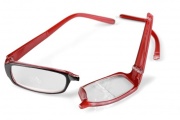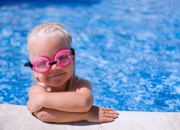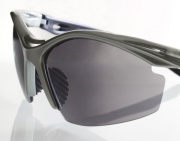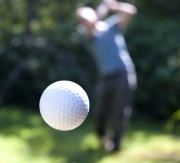Eyewear for Sports: Protection and Performance
Introduction
Participating in sports is healthy and the activity is good for everyone. Each type of sport requires different visual skills, just as it does physical skills like speed, agility, strength and balance. The best eyewear for sports will enhance vision and protect the eyes from injury at the same time.
We make recommendations for sports eyewear with these two goals in mind, although the discussion for each type of sport emphasizes eye protection and safety. The lenses in the eyewear are made to the best prescription to enhance clarity and ease of vision.
For impact resistance from fast-moving balls or equipment as well as other players, we recommend polycarbonate lenses for their almost-indestructible impact resistance.
Racquet Sports: Tennis, Badminton, Squash, Racquetball and Ping-Pong
Eye injuries in racquet sports are fairly common, as balls, racquets and players are all moving quickly in a defined area. (This list also includes handball, because it has the same type of projectiles flying about in a confined space.)
For eye protection we recommend polycarbonate lenses in glasses or goggles. Goggles provide more protection than spectacle eyewear, as well as less interference with vision. Goggles may also be worn over contact lenses. It is also common for the fast-moving ball to cause damage or even break a pair of regular eyeglasses, although the glasses will provide some protection to the eyes.
There are specialty lenses available for tennis players, with lens tints to intensify the colour of the tennis ball, making it easier to track and enhancing a player’s game.
Basketball and Volleyball
Injuries from basketball and volleyball are mainly due to either a ball or a finger in the eye. Polycarbonate lenses in protective goggles that align closely to the face will protect the eyes from both large and small objects. If using eyeglasses or goggles, use an elastic band to keep the frames from falling off or becoming loose during play.
Baseball, Rugby, Soccer, Hockey and Football
In these rough contact sports, eye injuries result from balls or pucks hitting players when they use their bodies to block each other. In hockey, the stick becomes a source of injury as well. Both helmets and protective eyewear should be worn at all times, when permitted by game rules.
Swimming
Indoor and outdoor swimming pools are commonly sanitized with the use of chlorine, which is a corrosive substance that can damage the outer eye over time with extended exposure. Even after only a few hours in a highly chlorinated pool, many swimmers experience redness and irritation of the eyes.
Contact lens wearers should remove their lenses before entering the water, unless they are using watertight goggles over them. There are several reasons for this, including the possible loss of the lenses. Even with chlorinated water, there are microorganisms in the water that can cause serious eye infection. With soft lenses, the chlorine molecule binds with the lens material and this keeps it in contact with the ocular tissues for a longer period of time. While it is possible to swim with the eyes closed, there is still a risk of contamination or lens loss.
Prescription goggles are available for those who want to see more clearly underwater, and of course non-prescription goggles are perfect for those without need of prescription lenses or who wear contact lenses. Again, protect the contact lenses from contact with the water in the pool.
Non-prescription goggles are readily available at retail and specialty stores.
Surfing, Sailing, Water Skiing, Scuba Diving and Fishing
Outdoor water sports enthusiasts have several natural elements to contend with, including wind, reflected UV rays off the water, hard falls and the salt water itself. Shatterproof polycarbonate goggles will prevent the lenses from breaking and causing injury in a fall. Lenses should also have a specialized coating to reduce glare and reflected UV rays from entering the eyes. Polarized lenses are good for reducing glare off the water, and make it easier to see while sailing or fishing.
Similar to swim goggles, diving masks and goggles are available for outdoor water sports without a prescription. Some masks have prescription power in the lenses, but they will have the same prescription in both eyes, unless they are custom made with prescription lenses made to order.
Consult an eyecare practitioner if you wish to wear your contact lenses while scuba diving about the procedures to follow, to avoid either hard lenses pushing into the eye due to the increased pressure at depth, or soft lenses from attracting microorganisms in the water.
Skiing and Snowboarding
Skiing and snowboarding are great winter sports, but the eyes need protection from the reflected glare off the snow, wind, sun and accidental trauma. Polycarbonate lenses in frames of soft and flexible materials are the best choice for these sports. Traditional metal frames can become cold and brittle and thus prone to breakage.
Ski goggles should provide protection from both direct and reflected UV rays and glare. Usually, ski goggles are ventilated to keep them from fogging up for an unobstructed view. Some have polarized lenses to reduce the sun’s glare off the snow. Some goggles even come with additional, interchangeable, lenses of different tints for different weather conditions; a yellow tint, for example, will enhance contrast and make it easier to see obstacles and moguls. Most ski masks come with a wide strap that keeps them comfortably in place.
Ski goggles in general are usually large, as they provide protection not only to the eyes but to some of the face. However, some are smaller and could be mistaken for regular sunglasses, although they are designed to fit closely around the eyes and often have a wraparound design to provide a wide field of view.
Cycling
Cyclists must contend with wind and flying debris as potential causes of vision obstruction or eye injury. Well-fitted, aerodynamic polycarbonate lenses worn with an elastic strap to keep them in place will prevent injury and allow concentration on the path ahead. Wraparounds offer the best protection for cyclists, and most come with interchangeable lenses for different lighting and weather conditions.
Those who ride motorcycles should protect their eyes and face with a helmet that has a full-face shield, which will fit over prescription eyeglasses.
Hunting, Shooting, Archery and Golf
Any sport that involves flying projectiles such as bullets or arrows requires protective eyewear, preferably with polycarbonate lenses.
Specialty features such as flip-up sunglasses can help your eyes adjust to varying light conditions in wooded areas. Yellow or orange tints improve contrast and visual acuity in hazy, overcast or dark conditions. Brown or grey tints block sunlight on bright days, while red tints can enhance the target against a dark background of trees.
Polycarbonate lenses with UV protection and a scratch-resistant coating with an appropriate tint are the best choice for these particular sports.
Summing Up
As noted above, protecting the eyes is of utmost importance when participating in sports, indoors or out. It just makes sense to enhance your vision as well as protect your eyes to have the proper prescription in protective eyewear. Eye injuries are easily avoided, and protecting vision will help enhance performance as well.
As in sports, it is necessary to protect the eyes and vision whenever hazards exist for injury, even in everyday activities like hobbies or mowing the lawn. A simple pair of safety goggles worn over glasses or alone will prevent injury and will be well worth the small investment.





